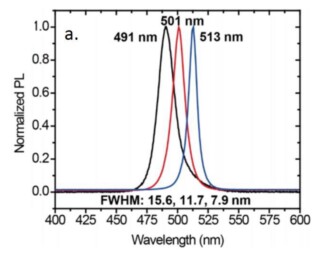Nanoco (LON: NANO), the British company known for producing, licensing and promoting cadmium-free quantum dot technology, has recently announced the formation of a wholly owned subsidiary, Nanoco 2D Materials Ltd.

Nanoco was originally a start-up out of Paul O’Brien’s group at University of Manchester, and it appears Nanoco has kept in close touch with the university since then. The newly formed Nanoco 2D Materials is based on work done in collaboration between Nanoco and Nobel laureate Professor Konstantin Novoselov at the University of Manchester. In fact, funding for development is through a loan from the university in the amount of £400k ($560k)
As the name implies, the new company will focus on 2-dimensional materials technology. 2D materials are single or a few atom thick planar morphology of other well-known electronic materials. Professor Novoselov won the 2010 Nobel prize in physics (jointly with Professor Andre Geim) “for groundbreaking experiments regarding the two-dimensional material graphene.” It is unclear if the newly formed company will focus on graphene, or other 2D electronic materials, but it’s safe to say that 2D materials could have far reaching impacts in displays.
Examples of 0D, 1D, 2D, and 3D carbon materials (souce: RSC Publishing)
If Nanoco is going after graphene for light emission, it won’t be the first public company doing so. Dotz Nano (ASX: DTZ) has been working on and selling graphene for light emission, but the properties are not even close to those required for displays. Based on their website offerings, it appears as though most products have broad emission (70+ nm), poor efficiency (20-30%) and do not absorb blue light well enough to be considered for current LED displays. With these properties, I remain skeptical about the potential of graphene as a quantum dot substitute.
Other types of 2D materials
Just like quantum dots, 2D nanomaterials have numerous potential applications such as catalysis, photovoltaics/light harvesting, electronics, lasers, and of course displays. This is not the first time 2D materials are being explored for display applications, in fact, a recent review of perovskite nanoplatelets (a 2D cousin of perovskite quantum dots) supports the idea that this type of material could be an ideal candidate for optical technologies (like LEDs for example) due to it’s simple synthesis, low cost, and high performance. Perovskites are relatively straightforward to make at large scale, and with impressive optical properties they are getting a lot of attention from display makers. If you will be attending SID Display Week 2018, you’ll notice an entire session on perovskites – definitely a technology to keep your eye on. (Check here for articles that we have produced on the topic – Man. Ed. – subscription required for some)
The classic quantum dot material, cadmium selenide, has also been explored in its 2D form, and the results are compelling. At only a few atoms thick, these thin sheets of CdSe have incredible emission properties with peak widths of <10 nm possible (compare that to typical CdSe QDs which are ~30 nm, and InP which are ~40 nm). Narrowing peaks means improved color gamut and efficiency of displays. Perhaps this is a viable path to Rec 2020?
 CdSe nanoplatelet emission can be very narrow compared to existing quantum dot technology (source: ACS Publications)
CdSe nanoplatelet emission can be very narrow compared to existing quantum dot technology (source: ACS Publications)
It is doubtful that Nanoco is pursuing Cd-containing materials given their firm stance on developing Cd-free technologies, but there are plenty of other 2D materials that do not contain Cd that could be adapted for displays.
When will we see 2D material products?
So why haven’t these 2D materials seen commercial success yet? In short – maturity. There have been tremendous advancements in their synthesis, characterization, and the ability to incorporate these materials into optical technologies, but we are still early in the life cycle and it’s still mostly an academic research area. Remember, quantum dots took decades of research before they were finally adopted in displays. Some of the key issues to overcome right now for 2D materials are stability, scalability, and purification. I suspect we still have a few years (at least) before these materials will start to enter the market.
Nanoco feels it’s worthwhile to pursue this intriguing class of materials, and I tend to agree. So, keep your eye on 2D materials, because these flat particles could be a key to flat screen technology with wide gamut.
Peter Palomaki is the owner and chief scientist at Palomaki Consulting, a firm specializing in helping companies solve big problems at the nanoscale. His utilizes his expertise in quantum dots and materials chemistry to solve challenging problems with clients large and small.

